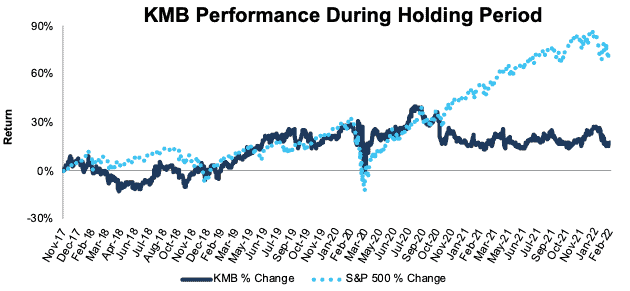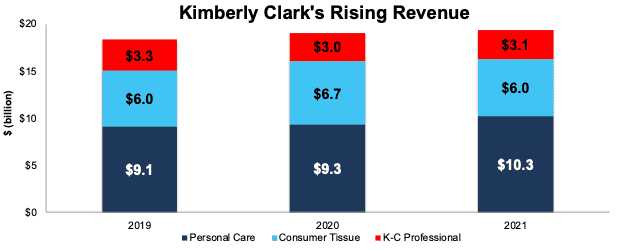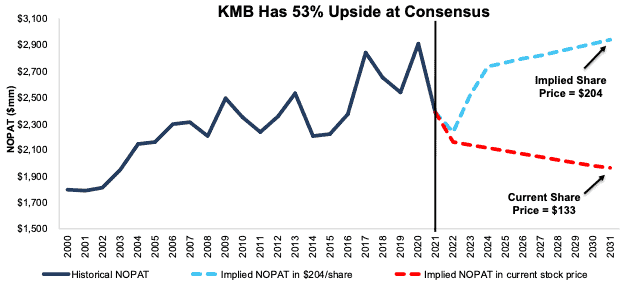We first made Kimberly-Clark Corp (KMB: $133/share) a Long Idea in November 2017. Since then, the stock is up 17% compared to a 68% gain for the S&P 500. Despite underperforming the market, the stock could be worth $204+/share today – a 53%+ upside. See our most recent report from May 2019 on Kimberly-Clark here.
We leverage more reliable fundamental data, as proven in The Journal of Financial Economics[1], and shown to provide a new source of alpha, with qualitative research to pick this Long Idea.
Kimberly-Clark’s Stock Has Huge Upside Based on:
- Greater scale in manufacturing and distribution, along with strong brand awareness, to profit from the growing demand for personal care and consumer tissue products.
- Demand in the company’s end markets is likely to stabilize in 2022, which will help profits improve toward pre-pandemic levels.
- Recent and planned price increases will improve the company’s profitability.
- The current valuation of the stock implies profits will permanently fall 30% below current levels.
Figure 1: Long Idea Performance: From Date of Publication Through 2/22/2022
Sources: New Constructs, LLC
What’s Working
Long-Term Demand Growth: Kimberly-Clark, through its large manufacturing and distribution network, provides products that meet the most basic of needs. These markets are forecasted for strong growth in the coming years, which will help the company reach pre-pandemic revenue and profits. The following is a list of market growth forecasts for the company’s major end markets.
- toilet paper: ~5% CAGR from 2021 to 2027 according to Report Ocean
- diapers: 7% CAGR through 2025 according to Research and Markets
- facial tissues: 6% CAGR through 2025 according to Research and Markets
- feminine hygiene: 6% CAGR from 2021 to 2030 according to Allied Market Research
Return to Normalcy: Kimberly-Clark’s consumer tissue products typically have a very stable level of demand. However, during the onset of the COVID-19 pandemic, consumer stockpiling caused a large increase in consumer tissue sales in 2020, which led to a lower-than-normal volume in 2021. Once consumers finish “destocking”, the company expects demand for its core segments to stabilize.
Despite the volatility in its product segments, Kimberly-Clark’s total revenue has grown 3% compounded annually since 2019. Per Figure 2, revenue for the company’s largest segment, personal care, has grown by 13% since 2019.
Figure 2: Revenue by Product Segment: 2019 – 2021
Sources: New Constructs, LLC and company filings
Cost Reduction Measures Are in FORCE: For years, the company has focused on reducing its cost structure through its Focused On Reducing Costs Everywhere (FORCE) program. This program continues to deliver positive results, as Kimberly-Clark’s marketing, research, and general expense as a percent of revenue fell from 19% in 2014 to 17% in 2021.
What’s Not Working
Falling Profitability: Rising material, labor, and energy costs in 2021, along with weakened demand for consumer tissue products have hurt profitability.
Kimberly-Clark’s net operating profit after tax (NOPAT) margin fell from 15% in 2020 to 12% in 2021, while invested capital turns fell from 1.11 to 1.05 over the same time. Falling NOPAT margins and invested capital turns drove the company’s return on invested capital (ROIC) from 17% in 2020 to 13% in 2021.
2022 Will Be Another Challenging Year: Falling profitability could extend through 2022, as the midpoint of management’s 2022 EPS guidance is 6% below 2021 EPS.
Looking past the next twelve months, the company’s profitability is likely to rise from current levels as demand for consumer tissue returns, planned price increases occur, and cost-savings measures bear fruit. Furthermore, there is a strong correlation between improving ROIC and increasing shareholder value, and Kimberly-Clark ties its executive compensation to an adjusted ROIC target. The company’s focus on ROIC aligns executive and shareholder interests and is likely to result in improved profitability over the long term.
Professional Products Remain Below Pre-Pandemic Levels: Kimberly-Clark’s professional products segment are still below 2019 levels and are likely to lag the growth of the company’s other segments in 2022. The strength in demand for work-from-home drives less demand for professional products.
Stock Is Priced For a 30% Profit Decline
Despite the fall in the company’s profitability, expectations for Kimberly-Clark’s future profits are too pessimistic and ignore end market growth estimates.
Kimberly-Clark’s price-to-economic book value (PEBV) ratio of 0.7 means the stock is priced for profits to fall, permanently, by 30% from current levels. Below, we use our reverse discounted cash flow (DCF) model to analyze the expectations for future growth in cash flows baked into a couple of stock price scenarios for Kimberly-Clark.
In the first scenario, we assume Kimberly-Clark’s:
- NOPAT margin falls to 11% (10-year low vs. 12% in 2021) from 2022 – 2031, and
- revenue falls by 2% (vs. 2022 – 2023 consensus CAGR of +2.5%) compounded annually from 2022 – 2031.
In this scenario, Kimberly-Clark’s NOPAT falls 2% compounded annually over the next decade and the stock is worth $133/share today – equal to the current price. For reference, Kimberly-Clark grew NOPAT by 1% compounded annually over the past 10 years.
Shares Could Reach $204 or Higher If Margins Recover to 10-Year Average
If Kimberly-Clark’s elevated costs for input materials revert to historical norms, and the company can successfully implement price increases, NOPAT margins should improve from current levels. If we assume Kimberly-Clark’s:
- NOPAT margin is 11% in 2022, 12% (equal to 2021) in 2023, and 13% (10-year average) from 2024 – 2031,
- revenue grows at a 2.5% CAGR (equal to 2022 – 2023 consensus) from 2022 – 2023, and
- revenue grows by just 1% compounded annually from 2024 – 2031, then
the stock is worth $204/share today – 53% above the current price. In this scenario, Kimberly-Clark’s NOPAT grows by just 2% compounded annually over the next decade, and its NOPAT in 2031 is just 1% above pandemic-driven 2020 levels. Should Kimberly-Clark grow NOPAT to higher levels, the stock has even more upside.
Figure 3: Kimberly-Clark’s Historical and Implied NOPAT: DCF Valuation Scenarios
Sources: New Constructs, LLC and company filings
This article originally published on February 23, 2022.
Disclosure: David Trainer, Kyle Guske II, and Matt Shuler receive no compensation to write about any specific stock, sector, style, or theme.
Follow us on Twitter, Facebook, LinkedIn, and StockTwits for real-time alerts on all our research.
[1] Our research utilizes our Core Earnings, a more reliable measure of profits, as proven in Core Earnings: New Data & Evidence, written by professors at Harvard Business School (HBS) & MIT Sloan and published in The Journal of Financial Economics.



